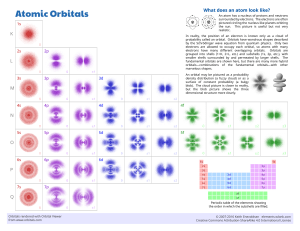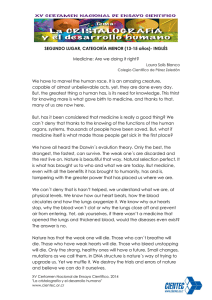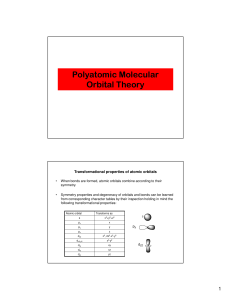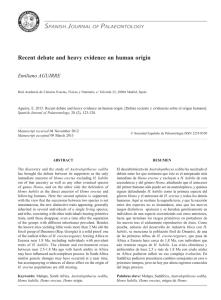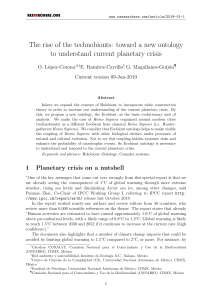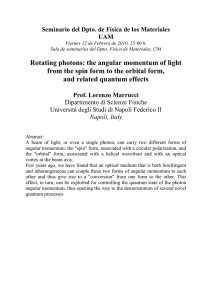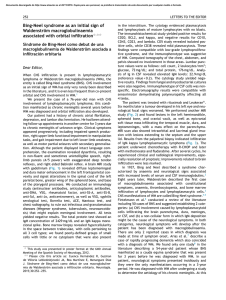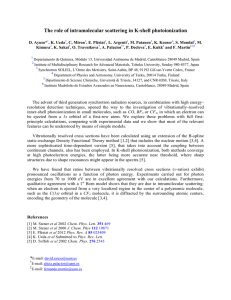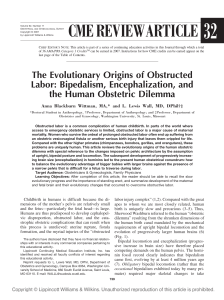Application of the Active Space Self-Interaction
Anuncio
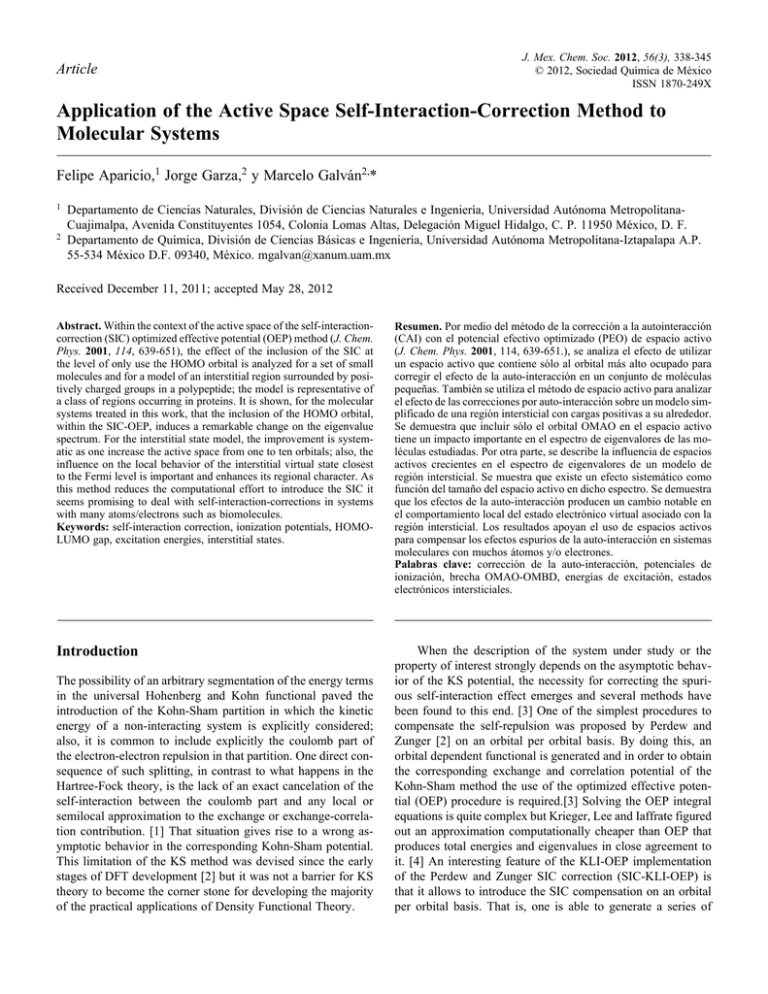
338 J. Mex. Chem. Soc. 2012, 56(3)
Article
J. Mex. Chem. Soc. 2012, 56(3), 338-345
Aparicio
et al.
© 2012, SociedadFelipe
Química
de México
ISSN 1870-249X
Application of the Active Space Self-Interaction-Correction Method to
Molecular Systems
Felipe Aparicio,1 Jorge Garza,2 y Marcelo Galván2,*
1
Departamento de Ciencias Naturales, División de Ciencias Naturales e Ingeniería, Universidad Autónoma MetropolitanaCuajimalpa, Avenida Constituyentes 1054, Colonia Lomas Altas, Delegación Miguel Hidalgo, C. P. 11950 México, D. F.
2 Departamento de Química, División de Ciencias Básicas e Ingeniería, Universidad Autónoma Metropolitana-Iztapalapa A.P.
55-534 México D.F. 09340, México. mgalvan@xanum.uam.mx
Received December 11, 2011; accepted May 28, 2012
Abstract. Within the context of the active space of the self-interactioncorrection (SIC) optimized effective potential (OEP) method (J. Chem.
Phys. 2001, 114, 639-651), the effect of the inclusion of the SIC at
the level of only use the HOMO orbital is analyzed for a set of small
molecules and for a model of an interstitial region surrounded by positively charged groups in a polypeptide; the model is representative of
a class of regions occurring in proteins. It is shown, for the molecular
systems treated in this work, that the inclusion of the HOMO orbital,
within the SIC-OEP, induces a remarkable change on the eigenvalue
spectrum. For the interstitial state model, the improvement is systematic as one increase the active space from one to ten orbitals; also, the
influence on the local behavior of the interstitial virtual state closest
to the Fermi level is important and enhances its regional character. As
this method reduces the computational effort to introduce the SIC it
seems promising to deal with self-interaction-corrections in systems
with many atoms/electrons such as biomolecules.
Keywords: self-interaction correction, ionization potentials, HOMOLUMO gap, excitation energies, interstitial states.
Resumen. Por medio del método de la corrección a la autointeracción
(CAI) con el potencial efectivo optimizado (PEO) de espacio activo
(J. Chem. Phys. 2001, 114, 639-651.), se analiza el efecto de utilizar
un espacio activo que contiene sólo al orbital más alto ocupado para
corregir el efecto de la auto-interacción en un conjunto de moléculas
pequeñas. También se utiliza el método de espacio activo para analizar
el efecto de las correcciones por auto-interacción sobre un modelo simplificado de una región intersticial con cargas positivas a su alrededor.
Se demuestra que incluir sólo el orbital OMAO en el espacio activo
tiene un impacto importante en el espectro de eigenvalores de las moléculas estudiadas. Por otra parte, se describe la influencia de espacios
activos crecientes en el espectro de eigenvalores de un modelo de
región intersticial. Se muestra que existe un efecto sistemático como
función del tamaño del espacio activo en dicho espectro. Se demuestra
que los efectos de la auto-interacción producen un cambio notable en
el comportamiento local del estado electrónico virtual asociado con la
región intersticial. Los resultados apoyan el uso de espacios activos
para compensar los efectos espurios de la auto-interacción en sistemas
moleculares con muchos átomos y/o electrones.
Palabras clave: corrección de la auto-interacción, potenciales de
ionización, brecha OMAO-OMBD, energías de excitación, estados
electrónicos intersticiales.
Introduction
When the description of the system under study or the
property of interest strongly depends on the asymptotic behavior of the KS potential, the necessity for correcting the spurious self-interaction effect emerges and several methods have
been found to this end. [3] One of the simplest procedures to
compensate the self-repulsion was proposed by Perdew and
Zunger [2] on an orbital per orbital basis. By doing this, an
orbital dependent functional is generated and in order to obtain
the corresponding exchange and correlation potential of the
Kohn-Sham method the use of the optimized effective potential (OEP) procedure is required.[3] Solving the OEP integral
equations is quite complex but Krieger, Lee and Iaffrate figured
out an approximation computationally cheaper than OEP that
produces total energies and eigenvalues in close agreement to
it. [4] An interesting feature of the KLI-OEP implementation
of the Perdew and Zunger SIC correction (SIC-KLI-OEP) is
that it allows to introduce the SIC compensation on an orbital
per orbital basis. That is, one is able to generate a series of
The possibility of an arbitrary segmentation of the energy terms
in the universal Hohenberg and Kohn functional paved the
introduction of the Kohn-Sham partition in which the kinetic
energy of a non-interacting system is explicitly considered;
also, it is common to include explicitly the coulomb part of
the electron-electron repulsion in that partition. One direct consequence of such splitting, in contrast to what happens in the
Hartree-Fock theory, is the lack of an exact cancelation of the
self-interaction between the coulomb part and any local or
semilocal approximation to the exchange or exchange-correlation contribution. [1] That situation gives rise to a wrong asymptotic behavior in the corresponding Kohn-Sham potential.
This limitation of the KS method was devised since the early
stages of DFT development [2] but it was not a barrier for KS
theory to become the corner stone for developing the majority
of the practical applications of Density Functional Theory.
339
Application of the Active Space Self-Interaction-Correction Method to Molecular Systems
SIC corrected Kohn-Sham potentials with their corresponding
eigenvalue spectra and eigenstates in which the SIC compensation includes one, two, … etc occupied orbitals; this procedure
was called “active space” self-interaction-correction method; in
this context, if all occupied orbitals are included the procedure
is called full SIC.[5] The main conclusions of the analysis of
such series of potentials and eigenvalues spectra in atoms are
the following: [5] 1) the exact asymptotic behavior of the KS
potential is reached by using one orbital, the highest occupied
molecular orbital (HOMO), as the active space; 2) the internal
oscillations of the KS potential, related to the shell structure,
are only reproduced if the orbitals belonging to the inner shell
are included; 3) the full SIC eigenvalue for the HOMO orbital
is almost achieved when the valence shell orbitals are included
in the active space; the lowest unoccupied molecular orbital
eigenvalues require a smaller active space than the HOMO
to reach a closer value to the full SIC number. An appealing
feature of the active space self-interaction-correction (AS-SIC)
method is that it is suitable to obtain an approximate compensation of the self repulsion for any local or semilocal exchange
and correlation functional at a reduced computational effort; in
fact the correction to the asymptotic limit of the Kohn-Sham
potential is achieved by using only the HOMO as active space
and this particularly approximation is suitable for the improvement of the virtual LUMO state.
In this work, we address the AS-SIC effect on a set of
small molecules and in an interstitial state typical of those that
may occur in polypeptide environments. As the objective is to
show the main effects induced by the compensation of the self
repulsion on an orbital per orbital scheme in the systems under
study, our analysis is restricted to an exchange only functional
but it is important to notice that the procedure can be used with
any local or semilocal exchange and correlation functional.
The rationale to test the AS-SIC method in interstitial
states is related the fact that, in some cases, the folding process
in proteins gives rise to the formation of positively charged regions associated to lateral chains of aminoacids such as lysine
and arginine. It has been detected many of such regions in the
protein data bank. [6] Also, there is recent evidence that ionizable groups reside stable in the inner core of proteins. [7] If
the positive charged region is a sort of cavity or invagination,
the LUMO band of the protein may contain interstitial states,
defined as electronic virtual states associated to the cavity surrounded by positive charges rather than to a particular set of
atoms. [8] The interstitial states in polypeptides share with
positive defects in solids, the characteristic of being a challenge
for their appropriate treatment using approximations for the
exchange and correlation potential within density functional
theory (DFT)-Kohn Sham methods due to the failure of an appropriate asymptotic behavior far from nuclei. [2] In addition,
interstitial regions are structures involving many atoms and
sometimes are in the limit of the size that is feasible to study
using DFT electronic structure calculations.
The manuscript outline is as follows, in section II a summary of the AS-SIC method is presented in order to stress the
orbital per orbital basis character of the method. Section III
give the description of the methodology used and section IV
displays the results and discussion. Finally we give in section
V a summary of our findings.
The active space sic-oep approach
The self-interaction correction. Perdew and Zunger suggested
an easy way to remove the self-interaction energy on any approximation to the exchange-correlation functional [2]. The
idea of this SIC is quite simple because the contribution to the
two-electron interaction is evaluated with each occupied orbital
density, and the result is subtracted from the total exchangecorrelation energy in the following way
SIC
E XC
[{
N
,
i 1
i
approx
}]
E XC
approx
[
( E XC
[
,
J[
, 0]
i
]
i
])
.
1
approx
In this equation, the E XC represents any approximation
to the exchange-correlation functional in its spin-polarized version and J represents to the coulomb contribution. The sums in
equation 1 are evaluated over the spin contribution, σ = α, β,
and over the number of electrons with a defined spin, Ns.
The optimized effective potential. The Perdew and Zunger
proposal gives an important characteristic on the exchange-correlation contribution since now this quantity depends explicitly
on each occupied orbital and consequently the associated potential will be dependent on each orbital too. In order to obtain
the same potential for the occupied and unoccupied orbitals,
Sharp and Horton [9], and Talman and Shadwick [10] proposed
the minimization of the total energy with respect to a local potential instead of the minimization with respect to each orbital
E [{
V
}]
i
.
2
V OEP
In this equation the total energy depends explicitly on
each orbital and the optimized effective potential, Vs! OEP, is that
potential that satisfies this equation. The OEP will be a local
potential if the orbitals, occupied and unoccupied, satisfy
1
2
2
V OEP ( r )
(r)
i
i
i
( r ).
3
Applying the chain rule on equation 2 and elements of
perturbation theory we obtain
dr
i
*
k
E KS
i (r ) k
complex conjugate
(r)
i
1
k i
(r )
k
k
i
(r)
.
4
0
Because the Kohn-Sham energy, EKS, is written as
N
E KS
i
,
J[ ]
i 1
SIC
E xc
[{
i
}]
1
2
2
i
dr ( r ) ( r )
,
5
340 J. Mex. Chem. Soc. 2012, 56(3)
Felipe Aparicio et al.
For the implementation of this approach it is important to
take into account the restriction on the second sum in the last
is!
equation, where the HOMO is not included. The constants u XC
are defined as
the equation 4 has the form
1
2
dr
i
2
(r )
dr
|r
i
*
i
(r)
(r )
i
i
k i
*
i
k
SIC
E xc
1
(r )
(r )
r |
(r )
.
(r )
i
-
0
N
V OEP ( r )
dr
|r
i
(r )
*
k
(r)
(r )
k
k
k 1
k i
*
i
i
j
(r )
(r )
i
and
.
*
i
(r )
(r)
i
7
0
dr
(r )
|r
( r ),
r |
GE xc
1
,
M ( r ) GM iV ( r ) dr [ V xcOEP ( r )
8
u ixc ( r )]
i
*
k
(r)
(r )
k
k
k 1
k i
i
*
i
(r )
i
(r)
.
0
10
.
11
By the definition 8, the equation 3 is written as
i
1 2
2
(r)
(r )
dr
(r)
|r r |
i (r)
i
V xcOEP
The Krieger, Li and Iafrate approximation to the optimized
effective potential equations. Krieger, Li and Iafrate (KLI) designed an approach to avoid the evaluation of the infinite sums
OEP
in equation 10 [4]. With this approximation the V XC
s! potential
is obtained from
V xcOEP
KLI
N
i 1
i HOMO
N
(r)
i
i
( r ) u ixc ( r )
i 1
( r )[ V xcOEP KLI
(r)
(r)
i
u xc
( r )]
13
KLI , i
i
u xc
j
S
V xcj
u xc ,
14
HOMO )
N
dr
(r)
j
dr
i 1
(r)
(r)
i
;
.
15
(r)
approx
approx
E xc
E xc
dr
i
i
(r )
|r
r |
. 16
Using the KLI approximation, the procedure to find the
OEP-KLI is the following. For a given set of spin – orbitals, evaluate the constants defined in equations 13 and 15 to
OEP KLI , i
find the average values V XC
from equation 14. These
OEP KLI , i
values are used in equation 12 to determine the
V XC
OEP KLI
OEP-KLI, V XC
. With this potential, new spin-orbitals can
be obtained from equation 11 and the iterative procedure continued until convergence is reached.
Details on the implementation of this approach for atoms
and molecules can be found in the references [11,12].
The active space in the SIC-OEP approach. Garza et al.
found that the incorporation just of the HOMO in the SICOEP-KLI approach ensures the correct asymptotic behavior of
the exchange-correlation potential. [5] Such a conclusion was
reached when one by one orbital was incorporated in the evaluation of the exchange-correlation energy and in the construction
of the OEP. Thus, when the HOMO is included exclusively in
this approach the equation 1 has the form
SIC
E xc
[{
approx
E xc
[
approx
E xc
}]
i
HOMO ,
0]
[
,
J[
]
HOMO ]
,
17
and the equation 12 becomes as
.
j
( r ) u ixc ( r )
i
(r)
and
9
*
iV
equation 7 becomes as
,(N
M ji
V OEP ( r )
u ixcV ( r )
M ij )( V xcOEP
ij
( r ) u ixc ( r ),
i
are obtained from
S
V xcj
u ixc ( r )
V xcOEP ( r )
1, 2 ,
E xc
Defining
i 1
dr
with
r |
1
(r )
KLI ,i
HOMO
(
Inserting equation 3 in equation 6
dr
i
u xc
OEP
and the V XC
s!
(r)
i
6
12
OEP
s
V XC
XC !
KLI
(r)
O,s
r
HOMO !
O,s
# HOMO
(
r
)
u
(r)
XC
!
.
rs(r)
# (r)
18
For the asymptotic region
lim V xcOEP
|r |
KLI
(r)
HOMO
u xc
( r ),
19
341
Application of the Active Space Self-Interaction-Correction Method to Molecular Systems
and by using equation 16 it is obtained that
lim V xcOEP
KLI
|r |
(r)
HOMO
dr
|r
(r )
r |
.
20
Thus, the correct asymptotic behavior of the exchangecorrelation potential is obtained by using just the HOMO in
the SIC-OEP-KLI approach. This is an important result since
a large part of the work involved in the evaluation of equations
1 and 12 can be avoided. Naturally, when additional orbitals are
included with the HOMO (active space in the SIC-OEP-KLI
approach) the orbital energies are closer to the results obtained
with the full SIC-OEP-KLI approach. It is worth to note that
such an analysis was obtained exclusively for atomic systems
and to our knowledge there is not any report where the SICOEP-KLI approach, coupled with the active space, is applied
on molecular systems.
Computational details
All of the calculations reported in this work were done with the
NWChem program [13]. In order to describe the effects of the
size of active space included on the self-interaction corrections,
we computed the electronic structure of a set of small organic
molecules (see Table 1). Geometries of all of the molecules
considered in this study were fully optimized by using the
Hartree-Fock (HF) method and the Exchange only local-density approximation using the Slaters´s functional (XLDA); in
both cases the basis set used was the cc-pvtz. Analytic second
derivative calculations, which yield the harmonic vibrational
frequencies, were performed at the optimized geometries on
the two levels of theory, to ensure that the optimized geometries are minima on the potential energy hypersurface (all
real frequencies). To obtain the SIC, single point calculations
were done with the SIC-OEP-KLI method implemented in the
NWChem code. [13] The geometries came from an optimization at the XLDA/cc-pvtz level of theory; and the same basis
set and exchange only functional was used in the SIC-OEPKLI single point calculations. In order to analyze the effect of
the correction including only the HOMO orbital, two different
active spaces were used for the AS-SIC calculations: the first
one defined by the HOMO, and the second one defined by
the complete set of occupied molecular orbitals, full-SIC. As
a case study for the evaluation of the self-interaction effects
on interstitial states, we use the positive charged region the
BgK toxin previously reported by our Group. [8] According
to that we computed the electronic structure of a model of two
guanidinium groups on the geometry of the Arg21 and Arg27
residues of the BgK protein. (see Figs. 1 and 2) Single point
calculations of this model were done at the XLDA/cc-pvtz level
of theory and using the AS-SIC procedure with the same basis
set and exchange only functional. In the AS-SIC calculations,
three different active spaces were used: the HOMO, the five
higher occupied molecular orbitals, and the ten higher occupied
molecular orbitals.
Results and discussion
In exact KS DFT theory only the HOMO eigenvalue (εHOMO)
has a rigorous physical interpretation and corresponds to the
negative of the first ionization potential (IP) [14,15]. It has been
demonstrated that, with the SIC included in some exchangecorrelation approximations, the negative of the calculated HOMO energies are much closer to the corresponding first IPs and
the calculated HOMO-LUMO gaps are also closer to the first
electronic excitation energies (τ) [3, 5,11,12].
Let us first focus on the HOMO energies. Table 1 summarizes the results obtained for the HOMO eigenvalue for a
set of small molecules. As it is expected Hartree Fock values
are quite close to the ionization potential in contrast to the
Table 1. Experimental Ionization Potential (IP) compared to calculated HOMO eigenvalues for neutral
molecules. The calculations were done at HF/cc-pvtz, and XLDA/cc-pvtz levels of theory. Columns 4 and 5
contain, respectively, the results from AS-SIC with an active space containing all the occupied orbitals (fullSIC procedure) and only the HOMO orbital. The experimental data are taken from reference 16.
εHOMO (eV)
Molecule
-IP (eV) Experiment
HF
XLDA
XLDA SIC-OEP(full-SIC)
XLDA AS-SIC(HOMO)
CO
-14.99
-7.76
-13.84
-10.59
-14.01
N2
-16.57
-8.92
-13.76
-10.48
-15.58
H2O
-13.70
-5.56
-12.38
-8.50
-12.62
NH3
-11.66
-4.75
-10.79
-7.60
-10.07
NH4+
-26.77
-19.30
-25.04
-20.76
—
C2H4
-10.36
-5.66
-10.06
-7.34
-10.51
C2H6S2
-9.75
-4.48
-6.57
-4.86
-9.30
CH3CHCl2
-11.92
-6.05
-7.87
-6.19
-11.04
Pyridine
-9.48
-4.65
-8.54
-7.96
-9.26
342 J. Mex. Chem. Soc. 2012, 56(3)
a)
b)
Fig. 1. Structure of the BgK toxin. Panel a) shows the structure of the
toxin obtained from the Protein Data Bank [17]. The amino acid sequence is VCRDWFKETACRHAKSLGNCRTSQKYRANCAKTCELC. To have a point of reference in the structure, N and C letters mark the
amino and carboxylic endings, respectively; the disulfide bridges are
rendered with yellow sticks. The region marked by Arg21 and Arg27
contains the interstitial state (see reference 8). Panel b) shows the
conformation of Arg21 and Arg27 residues in the first NMR structure
of BgK reported on ref. 17. The protein structure was simplified by
removing all of the atoms beyond the site marked with letter R, in
order to obtain the guanidinium system.
Felipe Aparicio et al.
in each value achieved by the simplest active space, the general
trend is also close to the full-SIC behavior as can be seen in
figure 3. Also, one may say that the observed linear relationships between eigenvalues and experimental IPs for atoms are
also present but for SIC corrected values it is not as good as for
the Hartree-Fock and XLDA methods (see Fig. 4). In relation
to the HOMO-LUMO gap, associated to excitation energies,
the results shown in Table 2 compare this quantity with the
experimental first excitation energies for the set of molecules.
The calculated results are collected in Tables 1 and 2 with
available experimental data. Once again, the performance of the
AS-SIC-HOMO is remarkable: the correction in the numeric
values, as well as the general trend, is almost equivalent to the
XLDA and full-SIC results as one may conclude of the analysis
of Table 2 and figure 5.
Now, let us focus on the model of interstitial states. In
the case of a molecular system, the interest of using the ASSIC approach comes from the idea to improve the description
of what are called the valence molecular orbitals. Therefore,
figure 6 shows the behavior of the eigenvalues of the ten highest occupied and the ten lowest unoccupied states of a system
build as two interacting guanidinium groups. The effects of
the size of the active space on the SIC are shown on the figure
4. If we analyze the impact of the size of the active space in
the HOMO eigenvalue, one may say that including only the
HOMO in the active space stabilizes the HOMO by 13.55
kcal/mol, as compared to the non corrected value; the use the
five higher occupied molecular orbitals as the active space,
stabilizes the same orbital by 15.19 kcal/mol; and if the active
space includes the ten higher occupied molecular orbitals, the
HOMO eigenvalue is shifted 22.34 kcal/mol. Also, the use of
the active space with only the HOMO induces that the HOMO
and HOMO-1 become almost degenerate, a situation that is
mantained up to the use of an active space of ten orbitals. In
relation to the LUMO eigenvalue, a similar behavior to the one
Fig. 2. Schematic representation of the zwitterionic form of an arginine residue (Arg). The guanidinium group is indicated by the dashed
rectangle on the left.
exchange only LDA values that underestimate the IPs. The
full-SIC and AS-SIC-HOMO approaches move the data in the
right direction; and as it is seen in atoms the use of the HOMO
orbital in the active space represent a large improvement. What
is important to notice, is that, in addition to the large correction
Fig. 3. Experimental negative ionization potential (-IP) compared to
the calculated HOMO eigenvalues for molecules. The experimental
data are taken from [16].
343
Application of the Active Space Self-Interaction-Correction Method to Molecular Systems
Fig. 4. Correlation of the experimental negative ionization potential (-IP) versus the εHOMO values calculated at (a) HF/cc-pvtz (HF), (b) XLDA/cc-pvtz (XLDA), (c) Full SIC-OEP XLDA/cc-pvtz (full SIC),
and (d) Active space SIC correction at the XLDA/cc-pvtz level of theory inlcuding only the HOMO in
the “active space” (AS-SIC-HOMO).
a)
Fig. 5. Experimental first electron excitation energies (τ) compared to
the calculated HOMO-LUMO energy gaps for a subset of the molecules. The experimental data are taken from NIST data base [16].
observed in atoms is remarkable: the LUMO eigenvalue is less
sensitive to SIC corrections.
The interstitial state in the model is the LUMO+2 orbital;
its eigenvalue remains practically unchanged until the active
space of five orbitals and it slightly change for the active space
of ten orbitals. With respect to the local behavior, the SIC induces a significant change in the shape of the orbital. Indeed,
b)
Fig. 6. Comparison of the local behavior of the interstitial state (LUMO + 2) in the guanidinium model between the standard XLDA and
the full-SIC calculations. The plane for the contour plot is defined
by the three hydrogen atoms close to the interstitial region. Panel (a)
corresponds to the standard XLDA calculation and panel (b) to the
full-SIC procedure. The contour values for both panels in atomic units
are 0.015, 0.018, 0.021, 0.024, and 0.027. The calculations were done
at XLDA/cc-pvtz level of theory.
the SIC corrected orbital behaves more as a state belonging to
the intermediate region between the two charged groups.
Conclusions
As has been pointed out in section II, the use of an active space
containing only the HOMO orbital is enough to ensure the
correct asymptotic behavior of the Kohn-Sham potential. This
344 J. Mex. Chem. Soc. 2012, 56(3)
Felipe Aparicio et al.
Table 2. Experimental first excitation energy (τ) compared to HOMO-LUMO gap obtained from HF/
cc-pvtz, and XLDA/cc-pvtz levels of theory. Columns 4 and 5 contain, respectively, the results from
AS-SIC with an active space containing all the occupaied orbitals (full-SIC procedure) and only the
HOMO orbital. The values marked with * correspond to unbounded LUMO eigenvalues. NC means the
calculation does not converge. The experimental data are taken from reference 16.
εLUMO - εHOMO (eV)
Molecule
τ (eV)
HF
XLDA
XLDA SIC-OEP(full-SIC)
XLDA AS-SIC(HOMO)
CO
18.97*
6.79
6.41
7.72
6.3
N2
20.81*
8.07
7.96
8.45
7.8
H2O
17.22*
6.34*
7.31
8.18
7.1
NH3
15.17*
5.71*
6.47
7.38
5.7
NH4
23.53
13.31
13.60
13.22
—
C2H4
14.60*
5.66
5.82
5.93
4.4
C2H6S2
12.95*
4.27
3.96
4.44
—
CH3CHCl2
15.48*
5.82
NC
NC
—
Pyridine
12.54
3.84
3.81
3.94
3.7
+
will have a relevant impact in the description of the frontier
orbitals in molecular systems. As a consequence of that, the
trends in the IPs´ and excitation energies obtained are improved
and qualitatively follow the pattern of the experimental values.
However, in order to obtain an appropriate description of the local behavior of the KS potential in the whole range of distances
from the nuclei, the HOMO is not enough for the AS-SIC and it
is necessary to include an active space of more than one orbital
so that the SIC “touch” the whole valence region. For molecular
systems is less clear what particular orbital has more impact
when it is included in the active space and this will imply the
use of the AS-SIC with a careful calibration; that is, one has
to explore for each size of the active space what particular
orbitals have the larger impact. The SIC procedure could be
follows a localization procedure to gain efficiency in the use of
a restricted number of orbitals in the active state. With respect
to the use of SIC for the treatment of LUMO interstitial states,
one may say that it is expected strong changes in the local
behavior of such states when the SIC is included; also, the active space containing a single orbital (HOMO) could give the
main correction in the eigenvalues but the impact in the local
behavior remains as an open question. Due to the reduction in
the computer effort to include SIC effect, the AS-SIC method
seems to be a possibility to obtain reliable trends in the behavior
of ionization potentials and excitation energies in molecular
systems with many atoms or electrons.
Acknowledgements
We are pleased to contribute to this special issue dedicated to
Prof. José Luis Gázquez Mateos. He is a trailbreaker of the development of Density Functional Theory and a builder of generations of theoretical chemists in our country. Indeed, this work
is the result of collaboration between some of his academic off
springs. We want to take advantage of this opportunity to thank
Prof. Gázquez for his effort to promote theoretical chemistry in
México. We thank to Laboratorio de Supercómputo y Visualización en Paralelo at UAM-Iztapalapa for giving us access to
its computer facilities, and to CONACYT for financial support
(contract grants 155070 and 155698).
Fig. 7. Energetic behavior of highest occupied molecular orbitals and
lowest unoccupied molecular orbitals for the model of two guanidinium groups, (a) without SIC correction, (b) AS-SIC including only
the HOMO in the active space, (c) AS-SIC with an active space defined by the five highest occupied molecular orbitals, and (d) with an
active space defined by the ten highest occupied molecular orbitals.
The eigenvalues of HOMO and LUMO are reported explicitly in
atomic units.
References
1.Parr, R.G.; Yang, W. Density Functional Theory of Atoms and
Molecules, Oxford University Press, New York 1989.
2.Perdew, J.P.; Zunger, A. Phys. Rev. B 1981, 23, 5048-5079.
3.Kummel, S.; Kronik, L. Rev. Mod. Phys. 2008, 80, 3-60.
Application of the Active Space Self-Interaction-Correction Method to Molecular Systems
4.Krieger, J. B.; Li, Y.; Iafrate, G. J. Phys. Rev. A 1992, 45, 101-126;
Krieger, J. B.; Li, Y.; Iafrate, G. J. Phys. Rev. A 1992, 46, 54535458; Krieger, J. B.; Li, Y.; Iafrate, G. J. Phys. Rev. A 1993, 47,
165-181.
5.Garza, J.; Vargas, R.; Nichols, J.A.; Dixon, D.A. J. Chem. Phys.
2001, 114, 639-651.
6.No, K. T.; Nam, K. Y.; Scheraga, H. A. J. Am. Chem. Soc. 1997,
119, 12917; Magalhaes, A.; Maigret, B.; Hoflack, J.; Gomes, J.
N.; Scheraga, H. A. J. Protein Chem. 1994, 13, 195.
7.Isom, D.G.; Cannon, B. R.; Castañeda, C.A.; Robinson, A.; GarcíaMoreno E, B. Proc. Natl. Acad. Sci. 2008, 105, 17784-17788.
8.Aparicio, F.; Ireta, J.; Rojo, A.; Escobar, L.; Cedillo, A.; Galván,
M.; J. Phys. Chem. B 2003, 107, 1692-1697.
9.Sharp, R.T.; Horton, G. K. Phys. Rev. 1953, 90, 317-317.
10.Talman, J. D.; Shadwick, W. F. Phys. Rev. A 1976, 14, 36-40.
11.Garza, J.; Nichols, J. A.; Dixon, D. A.; J. Chem. Phys. 2000, 112,
7880-7890.
12.Garza, J.; Nichols, J. A.; Dixon, D. A.; J. Chem. Phys. 2000, 112,
1150-1157.
345
13.Valiev, M.; Bylaska, E.J.; Govind, N.; Kowalski, K.; Straatsma, T.
P.; van Dam, H. J. J.; Wang, D.; Nieplocha, J.; Apra, E.; Windus,
T. L.; de Jong, W. A. “NWChem: a comprehensive and scalable
open-source solution for large scale molecular simulations” Comput. Phys. Commun. 2010, 181, 1477-1489.
14.Janak, J. F. Phys. Rev. B 1978, 18, 7165-7168.
15.Perdew, J. P.; Parr, R. G.; Levy, M.; Balduz Jr., J. L. Phys. Rev.
Lett. 1982, 49, 1691-1694; J. P. Perdew, J. P.; Levy, M. Phys. Rev.
Lett. 1983, 51, 1884-1887.
16.NIST Computational Chemistry Comparison and Benchmark Data
Base, http://srdata.nist.gov/cccbdb/default.htm
17.The structure corresponds to the first of the 15 deposited structures
in the Protein Data Bank (http://www.pdb.org) for BgK toxin with
code 1BGK.
18.Dauplais, M.; Lecoq, A.; Song, J.; Cotton, J.; Jamin, N.; Gilquin,
B.; Roumestand, C.; Vita, C.; de Medeiros, C. L.; Rowan, E. G.;
Harvey, A. L.; Ménez, A. J. Biol. Chem. 1997, 272, 4302-4309.
